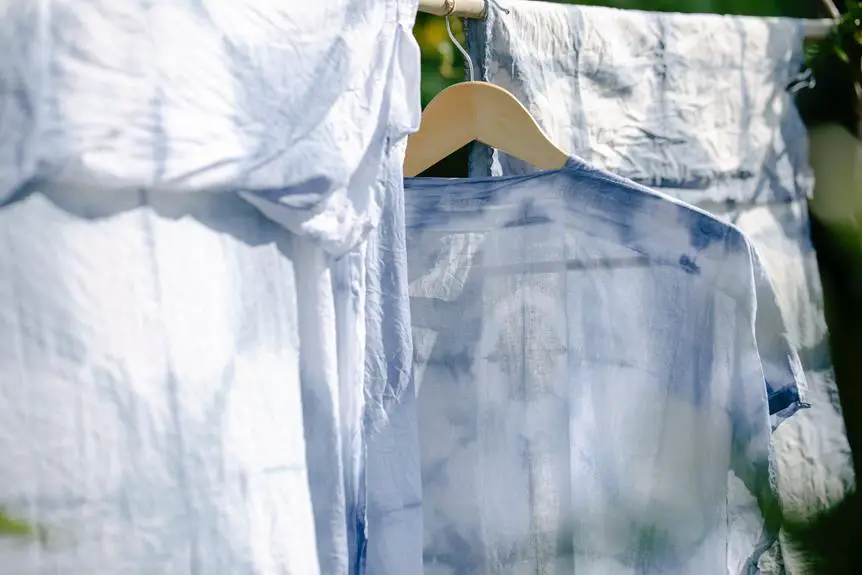You may not realize why laundry detergent is blue, but there are actually five key reasons behind it. Understanding the science behind the blue hue can help you master the intricacies of laundry care.
From brand differentiation to the use of optical brighteners, each reason serves a specific purpose in the formulation and marketing of laundry detergents.
By delving into these reasons, you'll gain a deeper insight into the industry's consumer perception, stain masking capabilities, and overall marketing strategy.
So, let's explore the fascinating world of blue laundry detergent and unravel the secrets behind its color.
Key Takeaways
- Blue color helps differentiate laundry detergent brands and conveys trust, dependability, and efficiency.
- Optical brighteners in blue laundry detergent enhance fabric appearance by absorbing UV light and emitting visible blue light.
- The blue hue in laundry detergent masks stains and gives the impression of cleaner clothes, enhancing the perception of cleanliness.
- Incorporating blue prominently in product packaging and branding, and leveraging its psychological influence in marketing materials, can enhance the visual appeal and cleaning power of blue laundry detergents.
Brand Differentiation
When choosing a laundry detergent, you can easily differentiate between brands by the color of the product. However, brand differentiation goes beyond just color. Many brands offer a variety of scent options, allowing you to personalize your laundry experience. From fresh linen to floral scents, the options are endless. This allows you to choose a detergent that not only cleans your clothes but also leaves them smelling exactly how you want.
Packaging design also plays a crucial role in brand differentiation. Some brands opt for bold and vibrant packaging, while others go for a more minimalistic look. The design can convey a lot about the brand's identity and the type of consumer they're targeting. Whether it's a sleek, modern look or a more traditional and reliable aesthetic, the packaging can influence your perception of the product.
In a competitive market, brands are constantly innovating to stand out. The combination of scent options and packaging design are just two ways brands set themselves apart. So, next time you're browsing the laundry aisle, pay attention to these details and choose a detergent that not only suits your cleaning needs but also aligns with your personal preferences.
Optical Brighteners
To further understand why laundry detergent is often blue, consider the role of optical brighteners, which are compounds added to detergents to enhance the appearance of fabrics under different lighting conditions. Optical brighteners work by absorbing ultraviolet light and re-emitting it as visible blue light, which can make fabrics appear whiter and brighter. These compounds are particularly effective on white and light-colored fabrics, making them seem cleaner and fresher. Optical brighteners don't actually remove stains or dirt; instead, they create an illusion of cleanliness by altering the way light interacts with the fabric.
| Chemical Composition | Fabric Appearance |
|---|---|
| Fluorescent dyes or pigments | Enhances brightness and whiteness of fabrics |
| UV-absorbing molecules | Absorbs UV light and re-emits it as visible blue light |
Understanding the chemical composition and function of optical brighteners provides insight into why laundry detergents, particularly those designed for white and light-colored fabrics, often appear blue. These compounds play a key role in enhancing the visual appeal of clothes by affecting the way light interacts with the fabric, ultimately creating the appearance of cleaner and brighter garments.
Consumer Perception
One key reason why consumers prefer blue laundry detergents is their perception of enhanced cleaning power. The color blue is often associated with trust, dependability, and efficiency according to color psychology. This association leads consumers to believe that blue laundry detergents are more effective at removing stains and dirt from their clothes.
- Color Psychology: Blue is often perceived as a color that promotes feelings of cleanliness and freshness, making consumers more likely to choose blue laundry detergents over other colors.
- Environmental Impact: Some consumers associate blue with eco-friendliness, linking the color to clear skies and clean water. This perception may lead them to believe that blue detergents are more environmentally friendly, even if the actual environmental impact of the detergent isn't directly related to its color.
- Marketing Influence: Companies often use blue packaging for laundry detergents to tap into consumers' perception of the color. This can subconsciously influence purchasing decisions, as consumers may gravitate towards blue products due to their perceived cleaning power.
Understanding consumer perception of blue laundry detergents can provide valuable insights for both manufacturers and marketers looking to appeal to consumers' preferences and desires for mastery.
Stain Masking
With its blue hue, laundry detergent serves to mask stains, providing an optical illusion of cleanliness and freshness. This can influence your perception of the detergent's effectiveness and impact your purchasing decision. The blue color in laundry detergents helps to mask the appearance of stains on your clothes, giving the impression that they are cleaner than they actually are. However, it's important to understand that stain removal and fabric care go beyond just visual appeal. While the blue color may make your clothes look cleaner, it's crucial to choose a detergent that also provides effective stain removal and maintains the quality of your fabrics.
| Stain Removal | Fabric Care | Visual Appeal |
|---|---|---|
| Removes tough stains | Preserves fabric quality | Provides optical illusion of clean clothes |
| Penetrates fabric fibers | Maintains color vibrancy | Masks the appearance of stains |
| Effective on various fabric types | Prevents fabric damage | Influences perception of cleanliness |
When choosing a laundry detergent, look for one that not only offers visual appeal but also prioritizes stain removal and fabric care. Remember, the blue color is just one aspect of the overall effectiveness of the detergent.
Marketing Strategy
When marketing laundry detergent, it's important to emphasize the benefits of the blue color in influencing consumers' perception of cleanliness. The color psychology behind blue suggests trust, dependability, and cleanliness, making it an ideal choice to enhance consumer appeal.
Here are three key strategies for leveraging the blue color in laundry detergent marketing:
- Product Packaging: Utilize the blue color prominently in the product packaging to create a visual impact on the shelf. The striking presence of blue can capture the attention of consumers and communicate a sense of purity and hygiene, driving purchase intent.
- Branding and Messaging: Incorporate the blue color into branding elements and messaging to reinforce the idea of cleanliness and efficacy. By associating the detergent with the calming and reassuring properties of blue, consumers are more likely to perceive the product as reliable and effective in removing stains and odors.
- Consumer Engagement: Leverage the psychological influence of blue through marketing materials, advertisements, and social media campaigns. Highlight the visual appeal of the blue detergent while emphasizing its cleaning power to resonate with consumers seeking a trustworthy and effective laundry solution.
Frequently Asked Questions
Does the Color of Laundry Detergent Affect Its Effectiveness in Cleaning Clothes?
The color of laundry detergent can affect its cleaning power. Color psychology suggests that blue is associated with cleanliness, which may influence perception. However, the effectiveness ultimately depends on the detergent's formulation and ingredients.
Are There Any Health Concerns Associated With Using Blue Laundry Detergent?
Using blue laundry detergent may pose health concerns due to the presence of artificial dyes and fragrances. These chemicals can cause skin irritation and respiratory issues. Additionally, the environmental impact of these additives is a growing concern.
How Do Manufacturers Decide on the Specific Shade of Blue for Their Laundry Detergent?
Manufacturers decide on the specific shade of blue for laundry detergent through the manufacturing process, considering consumer preferences. They use market research and color psychology to select a shade that appeals to consumers and conveys cleanliness.
Can the Blue Color of Laundry Detergent Cause Staining or Discoloration on Certain Fabrics?
The blue color of laundry detergent can potentially cause staining or discoloration on certain fabrics. It's essential to check fabric compatibility before use. Always follow care instructions to avoid any unwanted effects on your clothing.
Is There a Specific Reason Why Most Laundry Detergents Are Not Other Colors, Such as Green or Purple?
Laundry detergents are typically blue due to color psychology and marketing strategies. Blue is associated with cleanliness and freshness, making it an appealing choice for consumers. Marketers use this to convey a sense of effectiveness and purity.
- Kevlar Fabric Suppliers in Toronto: Finding the Best Deals - June 21, 2025
- Closest Fabric to Kevlar: Substitutes for Budget-Friendly Projects - June 21, 2025
- Encased Kevlar Fabric: Reinforcing Gear for Enhanced Safety - June 21, 2025





